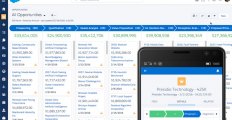When the coronavirus pandemic happened, organizations all over the world had to act quickly and shift their operations online. Many are also turning to digital technologies to remain competitive in the new normal. These include business intelligence software (BI)—a type of application that gathers, retrieves, analyzes, transforms, and reports on key data to help companies in making business decisions.
If you are starting your journey into the world of business intelligence (BI), this helpful guide is for you. It focuses on the common questions asked by new BI users. We anchored it on the software’s purpose while exploring other pertinent areas, such as what it is and what it can do for your business.
For a comprehensive look at this type of software, you can head over to our in-depth analysis of business intelligence and learn more about its features, types, and pricing.

The Purpose of Business Intelligence Table of Contents
- What is Business Intelligence?
- What Are the Benefits of Using Business Intelligence?
- Why Should You Use Business Intelligence Systems and Tools?
- How Does Software Tools Optimize Business Intelligence?
- What Are Examples of Business Intelligence Software Solutions?
- Who Should Lead the Way in Implementing Business Intelligence?
- How Should I Implement a Business Intelligence System?
- How to Efficiently Roll out Business Intelligence Systems?
- What Are Potential Business Intelligence Problems?
- How to Choose the Best Business Intelligence Software?
- What Are the Latest Trends in Business Intelligence?
- Can Small Business Use BI Software?
1. What Is Business Intelligence?
Business intelligence refers to the tools, technologies, applications, and practices that are used to collect, integrate, analyze, and present an organization’s raw data to create insightful and actionable business information. Adopting these data-driven business solutions can help make your organization more resilient to the negative impact of the pandemic. For example, BI includes data sharing and project management tools that facilitate collaboration, which has become vital to fostering teamwork and maintain workplace productivity, especially in a time where employees are forced to work from home.
BI, as a discipline and as a technology-driven process, is made up of several related activities, including:
- Data mining
- Online analytical processing
- Querying
- Reporting
2. What Are the Benefits of Using Business Intelligence?
Since you’re already aware of what is the purpose of business intelligence in a business, it’s worth tackling the question of what its main benefits are. For starters, BI and analytics can help companies manage fragile supply chains, increase customer engagement, and support workers as they adjust to the disruptions brought about by the pandemic.
The potential benefits of business intelligence programs include:
- Accelerating and improving decision-making
- Optimizing internal business processes
- Increasing operational efficiency
- Driving new revenues
- Gaining competitive advantages over business rivals.
- Identifying market trends
- Spotting business problems that need to be addressed
3. Why Should You Use Business Intelligence Systems and Tools?
Business intelligence tools are essentially data-driven decision support systems (DSS). BI is sometimes used interchangeably with briefing books, report and query tools, and executive information systems. With these tools, business people can start analyzing the data themselves rather than wait for IT to run complex reports. This information access helps users back up business decisions with hard numbers rather than with gut feelings and anecdotes.
In addition, with 54% of companies reporting that cloud BI has become critical to their operations, it may be best to explore its uses for your business to stay ahead of the curve.
4. How Do Software Tools Optimize Business Intelligence?
Business intelligence software systems provide historical, current, and predictive views of business operations, most often using data that has been gathered into a data warehouse or a data mart and occasionally working from operational data. Software elements support reporting, interactive “slice-and-dice” pivot-table analyses, visualization, and statistical data mining. Applications tackle sales, production, financial, and many other sources of business data for purposes that include business performance management. Information about other companies in the same industry are also gathered, a process known as benchmarking.
5. What Are Examples of Business Intelligence Software Solutions?
Sisense

Sisense is a business intelligence platform that lets users join, analyze, and picture out information they require to make better and more intelligent business decisions and craft workable plans and strategies.
After a thorough analysis of Sisense features, our software review experts concluded that this business intelligence solution gives you one of the easiest ways to create insights and business value from complex data. With Sisense, users can unify all the data they ever need and want into visually appealing dashboards via a drag and drop user interface. Sisense allows users to turn data into highly valuable insights and share them with colleagues, business partners, and clients via interactive dashboards. You can use all the features for free for a period of time to see if the software matches your needs.
Sisense is the leading business intelligence software for many companies, ranging from startups and developing enterprises to Fortune 500 giants, including eBay, Sony, ESPN, Comcast, and NASA. You can read our detailed review of Sisense, discussing its features, pricing, and user experience at length.
Wyn Enterprise

Wyn Enterprise is a browser-based, self-service business intelligence software that offers powerful features like data visualization and online document design. Wyn Enterprise pros and cons include the ability to combine data from multiple sources, so users can create complex reports and dashboards even without knowing how to code.
The platform lets you organize data and generate data sets. These data sets can be used for visually realistic interaction reports and dashboards. These reports can be generated regularly, and the dashboards can be viewed even on mobile devices as well. The vendor offers a comprehensive free trial to get you up to speed with the features.
Wyn Enterprise also offers three portals that can be used by administrators, end-users, and IT teams. This way, users can use their assigned portals for specific functions like configuring servers, creating reports, and performing administrative tasks. Data and images can also be uploaded for sharing if needed.
Zoho Analytics

Zoho Analytics is the data analytics app in the Zoho software family. It was formerly known as Zoho Reports, which was re-engineered into a more robust cloud-hosted platform that comes complete with online reporting, drill-down analytics, and self-service business intelligence. The software is designed to process big data, track KPIs, identify trends, and discover insights.
Zoho Analytics provides tools and capabilities to give you a complete picture of your business’ health and performance across the various units in your organization. It can consolidate data coming from different sources and give you reports through dashboards and visualizations. You can use all the features for free for a period of time to see if the software matches your needs.
Also, the software comes with a smart assistant named Zia, which harnesses AI natural language processing to provide you with answers through reports and KPI widgets in response to your questions. The BI solution integrates with most other Zoho apps as well as with dozens of external software and services. Although primarily a cloud-based platform, you also get the option to have Zoho Analytics deployed locally on your computer.
Sigma Computing

Sigma Computing is a cloud-based business intelligence and analytics platform that enables users to investigate, analyze, and obtain insights from their data. With its user-friendly interface and self-service capabilities, business users can make data-driven decisions rapidly.
The foundation of this business intelligence and analytics platform is its ability to connect to diverse data sources, including databases, cloud storage, and spreadsheets, among others. This capability allows users to access and consolidate data from multiple systems, eliminating the need for manual data extraction and consolidation. By providing a unified perspective of data, Sigma Computing enables users to develop a comprehensive understanding of their business operations.
One of the primary advantages of Sigma Computing is its user-friendly data exploration and visualization capabilities. Users can interactively navigate their data, drill down into specifications, and investigate relationships and patterns. The platform provides a variety of visualization tools, including charts, graphs, and dashboards, enabling users to communicate their findings in a visually appealing manner.
Qualtrics Research Core

According to the Qualtrics Research Core overview by our experts, it’s an easy-to-use enterprise market research platform that can be used for nearly any type of qualitative research. The platform uses machine learning and artificial intelligence to help analyze survey data.
The software comes with a drag-and-drop interface along with pre-made templates and over 100 question types, making survey building significantly easier. You’ll also get tools for quickly testing surveys. The platform supports multiple distribution channels, including email, social media, and SMS. You can take advantage of the Qualtrics Research Core free trial and get to know the features firsthand at no cost and without commitment.
Once you get your surveys back, you can use the platform’s Stats IQ feature to identify trends and statistical relationships and create predictive models. Additionally, Qualtrics Research Core has a Text IQ capability that uses AI and natural language processing to analyze open texts and rate text comments with sentiment scores.
The platform’s IQ directory serves as secure storage of customer information, too. The software can track your audience’s emotions, beliefs, and preferences, so you have a record that you can use for further research and business planning. An advanced Driver IQ function also automatically correlates customer information to key drivers of your business so you can optimize your marketing campaigns.
ActiveBatch

ActiveBatch is primarily a workflow automation software designed for businesses that want to automate IT workflows and business processes. However, the solution made it to our list thanks to its robust business intelligence and analytics module. This provides powerful tools that help businesses pinpoint, track, and manage IT workflows and systems with confidence.
Some of the notable ActiveBatch features include workflow monitoring, alerting tools, business intelligence features, operational and developer views, and SLA monitoring. Should you want to learn more about this product be sure to try the ActiveBatch free trial.
Particularly, the platform makes it a breeze to identify issues that precipitate job failure. And not just that, with the alerting tools, users can promptly respond to issues and address them before they escalate. Moreover, with the robust reporting and business intelligence features user can make informed decisions. On the other hand, the SLA monitoring tools enables companies to enforce policies that govern service delivery.
CXAIR Platform

Developed by Connexica, CXAIR Platform is designed to consolidate disconnected, unstructured data sets into a single information asset that you can use for more accurate reporting. The software arranges data in structured indexes and uses Apache Lucene search engine technology to make retrieval faster.
CXAIR Platform benefits also include actionable data insights that can drive business decisions. The platform comes with built-in data discovery capabilities, so they can easily get the answers they need from the data collected, which serves as a ‘single version of data truth’ for your organization. This ensures that the data used is consistent and always accurate. The vendor has an appealing free trial where you can tinker with the features at no cost.
The software lets you give users direct access to the data they need; they wouldn’t even need technical skills to navigate the CXAIR platform. Additionally, you can create pre-canned analyses and dashboards for users’ convenience. These tools can be personalized according to each user’s role and data access privileges.
CXAIR Platform is also flexible and scalable so that it can adjust to your organization’s IT infrastructure. Deploying the software is more affordable, too, as it can provide both data management and analytics for your organization.
Board

A comprehensive business intelligence solution, Board unifies critical business intelligence functions, such as data analysis, planning, simulation, and reporting in a single platform. Board’s capabilities also go beyond business intelligence–you can automatically use the data and insights provided by its business intelligence tools on your strategic planning and control cycles for better corporate performance management.
Board comes with an intuitive toolkit for codeless application design and creation. Using its user-friendly interface equipped with drag-and-drop tools, you can build and configure predictive models and other applications. Other core features of Board include workflow management, multi-user data entry, automated drill down, real-time modeling, reverse algorithm, MS office integration, and many others.
Furthermore, Board can be used by different industries from retail, manufacturing, automotive, to legal, and professional services. In terms of deployment, Board is primarily cloud-based but it has dedicated applications for mobile devices.
Salesforce Analytics Cloud

Salesforce Analytics Cloud provides advanced data analysis features powered by Einstein Analytics and Tableau. One of the main benefits of using Salesforce Analytics Cloud is that it uses advanced technologies such as natural language processing to support faster data discovery. The platform also allows the creation of datasets, models, and recipes, augmenting data analysis with AI and machine learning.
For instance, Salesforce Analytics Cloud features support rapid data exploration and implementation. Users will be able to analyze data more quickly and detect underlying patterns and correlations. Visualizations and explanations are also designed to be easily understandable by any user in the organization. With these capabilities, users can easily analyze data to answer questions, anticipate trends, and make data-based predictions of outcomes.
The platform also makes data easier to find through conversational explorations, which provide auto-suggestions based on fields in available datasets. Through this feature, users can use non-technical language to ask data-relevant questions and view answers in chart form. All these capabilities ensure that the most complex data is understandable and accessible to users of varying technical expertise.
Looker

Looker is a data platform with insights for every department. It’s a data-discovery app that provides an intuitive approach to data exploration. It offers a web-based interface that business users can utilize to tap into the expertise of their data analytics team.
They can build and share reports on the fly, so other functional groups can benefit from the questions they’re asking and the knowledge they’ve created. Looker reviews indicate that the platform can help all companies use data to drive their business decisions and activities in the right direction. There is a comprehensive Looker free trial, should you want to investigate the platform firsthand.
With a little bit of SQL knowledge, you won’t have any issues making Looker work for you or building your own analytic modules. You can design visualizations with a single code, as complexity depends only on how far you intend to go to refine your experience.
Looker’s ML code is there to help you produce and optimize your queries, which is particularly handy as most BI systems expect you to be an expert in the area.
6. Who Should Lead the Way in Implementing Business Intelligence?
Sharing is vital to the success of BI projects because everyone involved in the process must have full access to information to be able to change the way they work. BI projects should start with top executives, but the next group of users should be salespeople. Because their job is to keep abreast of the latest sales trends to increase sales and they’re often compensated on their ability to do so, they’ll be more likely to embrace any tool that will help them do just that—provided, of course, the tool is easy to use, and they trust the information.
With the help of BI systems, employees modify their individual and teamwork practices, which leads to improved performance among the sales teams and increased employee productivity. When sales executives see a big difference in performance from one team to another, they work to bring the laggard teams up to the level of the leaders.
Once you get salespeople on board, you can use them to help get the rest of your organization on the BI bandwagon. They’ll serve as evangelists, gushing about the power of the tools and how BI is improving their lives.
7. How Should I Implement a Business Intelligence System?
When charting a course for BI, companies should first analyze the way they make decisions and consider the information that executives need to facilitate more confident and more rapid decision-making, as well as how they’d like that information presented to them (for example, as a report, a chart, online, hard copy). Discussions of decision making will drive what information companies need to collect, analyze, and publish in their BI systems.
Good BI systems need to give context. It’s not enough that they report sales were X yesterday and Y a year ago that same day. They need to explain what factors influencing the business caused sales to be X one day and Y on the same date the previous year.
Like so many technology projects, BI won’t yield returns if users feel threatened by, or are skeptical of, the technology and refuse to use it as a result. And when it comes to something like BI, which, when implemented strategically, ought to fundamentally change how companies operate and how people make decisions, CIOs need to be extra attentive to users’ feelings.
8. How to Efficiently Roll out Business Intelligence Systems?
- Make sure your data is clean.
- Train users effectively.
- Deploy quickly, then adjust as you go. Don’t spend a huge amount of time upfront, developing the “perfect” reports because needs will evolve as the business evolves. Deliver reports that provide the most value quickly, and then tweak them.
- Take an integrated approach to building your data warehouse from the beginning. Make sure you’re not locking yourself into an unworkable data strategy further down the road.
- Define ROI clearly before you start. Outline the specific benefits you expect to achieve, then do a reality check every quarter or six months.
- Focus on business objectives.
- Don’t buy business intelligence software because you think you need it. Deploy BI with the idea that there are numbers out there that you need to find, and know roughly where they might be.
9. What Are Potential Business Intelligence Problems?
- User resistance — Implementations can be dogged by cultural challenges.
- Irrelevant and poor quality data — To get accurate insights, you must have standard data. Get your data in good working order before extracting and acting on insights.
- BI tools — The core of BI is reporting, not process management. Be careful not to confuse business intelligence with business analytics.
- Companies don’t understand their business processes well enough — Strive to understand all the activities that make up a particular business process before starting a BI project.
10. How to Choose the Best Business Intelligence Software?
- Analyze how executives make decisions.
- Consider what information executives need to facilitate quick, accurate decisions.
- Pay attention to data quality.
- Devise performance metrics that are most relevant to the business.
- Provide the context that influences performance metrics.
Remember, BI is about more than decision support. Due to improvements in the technology and the way CIOs are implementing it, BI now has the potential to transform organizations. CIOs who successfully use BI to improve business processes contribute to their organizations in more far-reaching ways than by implementing basic reporting tools.
11. What Are the Latest Trends in Business Intelligence?
The following are three of the latest trends in the business intelligence field:
- Data governance – With General Data Protection Regulation (GDPR) coming into effect in many regions in 2020, proper data governance is becoming a more pressing matter for many organizations. Data governance programs will become a requirement for companies who want to remain compliant.
- Explainable AI – This trend was born from the need to increase transparency in AI-powered business intelligence platforms. We’re expecting AI to be soon able to justify conclusions in a more intelligible manner. This will help users gain a better understanding of their data.
- Data Quality Management (DQM) – With businesses losing $3.1 trillion every year because of poor data quality, DQM is becoming a crucial process for ensuring the accuracy and usefulness of data. Though DQM is not a new trend, it’s expected to continue changing the business intelligence industry well beyond 2020.
12. Can Small Business Use BI Software?
Absolutely! With cloud-hosted and SaaS business intelligence solutions, the software has gone down to affordable levels and within easy reach to organizations of whatever size. Previously an exclusive tool of large corporations able to maintain expensive processors and systems to crunch and analyze big data, today’s BI software tools, being hosted online are cost-effective solutions that won’t break the bank.
Now, there are even self-service analytics and BI tools you can access and use without the need to have IT background to give you answers on your business health and performance as well as identify opportunities and trends to help you make information-driven decisions. In other words, BI has leveled the playing field. You, as a small business owner, get to use the tools that large businesses also use to gather insights on the market, the business environment, and their organization.
There is no question on the benefits of business intelligence when it comes to helping you reduce cost, improve revenues, minimize risk, speed up decision and action processes, and gain data visibility across your organization. The software will prove to be one of your most important business tools, especially when meeting the challenges presented by the COVID-19 global health crisis. To see how it works, go on a tour with our top product in the BI software category. Simply sign up for Wyn Enterprise free demo.
Key Insights
- Purpose of Business Intelligence: BI helps executives, managers, and other operational workers make better, informed business decisions, cut costs, identify new opportunities, and spot inefficiencies.
- Benefits of BI: It accelerates decision-making, optimizes processes, increases operational efficiency, drives revenue, offers competitive advantages, and identifies market trends and problems.
- Role During Pandemic: BI tools have been crucial for businesses to adapt to disruptions and maintain productivity during the pandemic.
- Examples of BI Software: Includes Sisense, Wyn Enterprise, Zoho Analytics, Sigma Computing, Qualtrics Research Core, ActiveBatch, CXAIR Platform, Board, Salesforce Analytics Cloud, and Looker.
- Implementation Leaders: Top executives should lead BI projects, followed by sales teams, to ensure widespread adoption and effective use.
- Implementation Strategy: Analyze decision-making processes, ensure data quality, provide necessary training, and focus on business objectives for successful BI implementation.
- Common BI Problems: User resistance, poor data quality, and a lack of understanding of business processes can hinder BI success.
- Trends in BI: Data governance, explainable AI, and data quality management are key trends shaping the future of BI.
- BI for Small Businesses: Cloud-hosted and SaaS solutions make BI accessible and affordable for small businesses, leveling the playing field with larger corporations.
FAQ
- What is the purpose of business intelligence in a business? The purpose of business intelligence in a business is to help corporate executives, business managers, and other operational workers make better and more informed business decisions. Companies use business intelligence to cut costs, identify new business opportunities, and spot inefficient business processes.
- What are the benefits of using business intelligence? Business intelligence accelerates decision-making, optimizes internal processes, increases operational efficiency, drives revenue, offers competitive advantages, and helps identify market trends and business problems that need addressing.
- How do software tools optimize business intelligence? BI software systems provide historical, current, and predictive views of business operations. They support reporting, interactive analyses, visualization, and statistical data mining, tackling data from sales, production, financial, and other sources to improve business performance management.
- Who should lead the way in implementing business intelligence? Top executives should initiate BI projects, followed by sales teams who are likely to embrace tools that help increase sales. Their success with BI can help evangelize the benefits to the rest of the organization.
- How should I implement a business intelligence system? Analyze decision-making processes and required information, ensure clean data, train users effectively, and deploy BI tools quickly. Focus on providing context and clarity in reports, and adapt the system as business needs evolve.
- What are potential business intelligence problems? Common issues include user resistance, poor data quality, and a lack of understanding of business processes. Addressing these challenges is crucial for successful BI implementation.
- What are the latest trends in business intelligence? Key trends include data governance to comply with regulations like GDPR, explainable AI for better transparency in data insights, and data quality management to ensure accuracy and usefulness of data.
- Can small businesses use BI software? Yes, with the advent of cloud-hosted and SaaS BI solutions, small businesses can afford and benefit from BI tools. These solutions offer data visibility, help reduce costs, improve revenues, minimize risks, and speed up decision-making processes.


























Leave a comment!